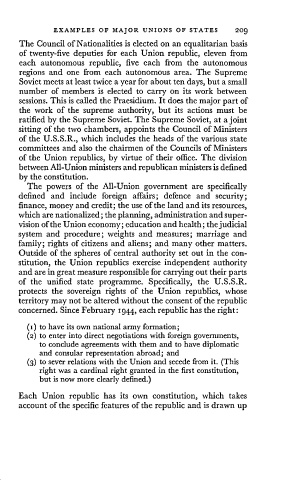Page 224 - Afrika Must Unite
P. 224
EXAMPLES OF MAJOR UNIONS OF STATES 209
The Council of Nationalities is elected on an equalitarian basis
of twenty-five deputies for each Union republic, eleven from
each autonomous republic, five each from the autonomous
regions and one from each autonomous area. The Supreme
Soviet meets at least twice a year for about ten days, but a small
num ber of members is elected to carry on its work between
sessions. This is called the Praesidium. It does the major part of
the work of the supreme authority, but its actions must be
ratified by the Supreme Soviet. The Supreme Soviet, at a joint
sitting of the two chambers, appoints the Council of Ministers
of the U.S.S.R., which includes the heads of the various state
committees and also the chairmen of the Councils of Ministers
of the Union republics, by virtue of their office. The division
between All-Union ministers and republican ministers is defined
by the constitution.
The powers of the All-Union government are specifically
defined and include foreign affairs; defence and security;
finance, money and credit; the use of the land and its resources,
which are nationalized; the planning, administration and super
vision of the Union economy; education and health; the judicial
system and procedure; weights and measures; marriage and
family; rights of citizens and aliens; and m any other matters.
Outside of the spheres of central authority set out in the con
stitution, the Union republics exercise independent authority
and are in great measure responsible for carrying out their parts
of the unified state programme. Specifically, the U.S.S.R.
protects the sovereign rights of the Union republics, whose
territory may not be altered without the consent of the republic
concerned. Since February 1944, each republic has the right:
(1) to have its ow n national arm y form ation;
(2) to enter into direct negotiations w ith foreign governm ents,
to conclude agreem ents w ith them and to have diplom atic
and consular representation abroad; and
(3) to sever relations w ith the U n io n and secede from it. (T his
right w as a cardinal right granted in the first constitution,
but is now m ore clearly defined.)
Each Union republic has its own constitution, which takes
account of the specific features of the republic and is drawn up

